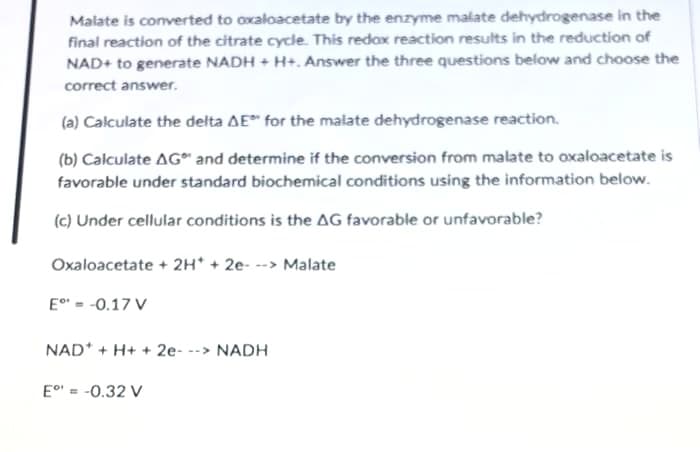Malate is converted to oxaloacetate by the enzyme malate dehydrogenase in the final reaction of the citrate cycle. This redox reaction results in the reduction of NAD+ to generate NADH + H+. Answer the three questions below and choose the correct answer. (a) Calculate the delta AE" for the malate dehydrogenase reaction. (b) Calculate AG* and determine if the conversion from malate to oxaloacetate is favorable under standard biochemical conditions using the information below. (c) Under cellular conditions is the AG favorable or unfavorable? Oxaloacetate + 2H* + 2e- --> Malate E - -0.17 V NAD* + H+ + 2e- --> NADH E = -0.32 V
Malate is converted to oxaloacetate by the enzyme malate dehydrogenase in the final reaction of the citrate cycle. This redox reaction results in the reduction of NAD+ to generate NADH + H+. Answer the three questions below and choose the correct answer. (a) Calculate the delta AE" for the malate dehydrogenase reaction. (b) Calculate AG* and determine if the conversion from malate to oxaloacetate is favorable under standard biochemical conditions using the information below. (c) Under cellular conditions is the AG favorable or unfavorable? Oxaloacetate + 2H* + 2e- --> Malate E - -0.17 V NAD* + H+ + 2e- --> NADH E = -0.32 V
Chemistry & Chemical Reactivity
10th Edition
ISBN:9781337399074
Author:John C. Kotz, Paul M. Treichel, John Townsend, David Treichel
Publisher:John C. Kotz, Paul M. Treichel, John Townsend, David Treichel
Chapter24: Biochemistry
Section: Chapter Questions
Problem 34GQ: The first step of the metabolic process known as glycolysis is the conversion of glucose to glucose-...
Related questions
Concept explainers
Organic Chemistry of Metabolic Pathways
Metabolic pathways allude to the arrangement of chemical catalyzed reactions that lead to the transformation of a substance into the final product. Metabolic pathways incorporate a progression of reaction where the substrate is changed continuously and the transitional metabolites are persistently recovered.
Glucogenesis
Glucogenesis is a metabolic pathway in which glucose is produced from carbon substrates that are not carbohydrates. This process is observed in plants, animals, fungi, bacteria and other micro organisms. The general definition for glucogenesis or gluconeogenesis is as follows,
Question

Transcribed Image Text:Malate is converted to oxaloacetate by the enzyme malate dehydrogenase in the
final reaction of the citrate cycle. This redox reaction results in the reduction of
NAD+ to generate NADH + H+. Answer the three questions below and choose the
correct answer.
(a) Calculate the delta AE for the malate dehydrogenase reaction.
(b) Calculate AG and determine if the conversion from malate to oxaloacetate is
favorable under standard biochemical conditions using the information below.
(c) Under cellular conditions is the AG favorable or unfavorable?
Oxaloacetate + 2H* + 2e- --> Malate
E° = -0.17 V
NAD* + H+ + 2e- --> NADH
E°' = -0.32 V
Expert Solution
This question has been solved!
Explore an expertly crafted, step-by-step solution for a thorough understanding of key concepts.
This is a popular solution!
Trending now
This is a popular solution!
Step by step
Solved in 2 steps

Knowledge Booster
Learn more about
Need a deep-dive on the concept behind this application? Look no further. Learn more about this topic, chemistry and related others by exploring similar questions and additional content below.Recommended textbooks for you

Chemistry & Chemical Reactivity
Chemistry
ISBN:
9781337399074
Author:
John C. Kotz, Paul M. Treichel, John Townsend, David Treichel
Publisher:
Cengage Learning

Chemistry & Chemical Reactivity
Chemistry
ISBN:
9781133949640
Author:
John C. Kotz, Paul M. Treichel, John Townsend, David Treichel
Publisher:
Cengage Learning


Chemistry & Chemical Reactivity
Chemistry
ISBN:
9781337399074
Author:
John C. Kotz, Paul M. Treichel, John Townsend, David Treichel
Publisher:
Cengage Learning

Chemistry & Chemical Reactivity
Chemistry
ISBN:
9781133949640
Author:
John C. Kotz, Paul M. Treichel, John Townsend, David Treichel
Publisher:
Cengage Learning


Introduction to General, Organic and Biochemistry
Chemistry
ISBN:
9781285869759
Author:
Frederick A. Bettelheim, William H. Brown, Mary K. Campbell, Shawn O. Farrell, Omar Torres
Publisher:
Cengage Learning